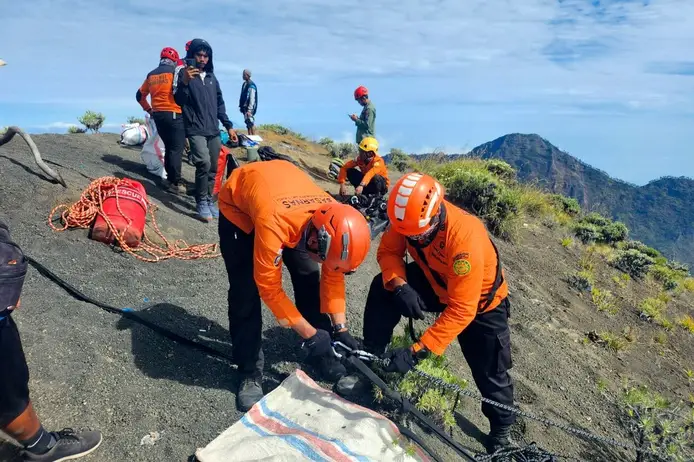Brazil Outraged: Juliana Marins Indonesia Volcano Tragedy
June 25, 2025 • 5 minute read.
What Happened to Juliana Marins on Mount Rinjani?
On June 21, 2025, 26-year-old Brazilian tourist Juliana Marins fell during a hike on Mount Rinjani, a 3,726-meter (12,224-foot) active volcano on Lombok Island, Indonesia. She had been trekking with a guide and a small group when fatigue led her to request a rest. Reports indicate the guide continued with others, and upon returning found only her flashlight; she had slipped down a steep ravine.

Rescue teams located Juliana via drone footage on June 22, but harsh terrain, dense fog, and unstable slopes delayed the rescue efforts. On June 23, ground teams attempted to descend to the location marked by the drone but were forced to pull back due to worsening fog and unsafe conditions . Finally, on June 24, rescuers reached her site and confirmed that she had died. Her body was recovered by ground team because helicopter evacuation was deemed too dangerous.
- June 21 morning: Juliana begins ascent early; reportedly requests a break due to fatigue.
- Later June 21: She slips into a ravine (~500–600 meters below the trail); drone footage captures her immobile.
- June 22–23: Multiple rescue attempts; weather deteriorates; guides and rescue teams face obstacles.
- June 24: Team reaches her location; confirms death. Body recovered by ground team due to unsafe helicopter conditions.

Rescue Efforts and Challenges
Mount Rinjani’s steep, loose volcanic soil, combined with fog and unstable weather, made aerial rescue unfeasible. Ground teams needed specialized anchors and ropes; initial equipment proved insufficient. Family statements later disputed narratives that she had received food or aid during those days.
Confirmation of Death and Official Statements
Brazil’s Foreign Ministry (Itamaraty) confirmed Juliana’s death and deployed diplomats to assist the family. The Indonesian authorities confirmed the outcome after locating her body at the initial site. Public statements highlighted sorrow and calls for reviewing safety protocols on popular volcano treks.
Brazilian and International Reaction
The news triggered a wave of indignation in Brazil. Many Brazilians expressed grief and anger over alleged lapses: the guide’s decision, rescue delays, and conflicting information. On Instragram, family members shared updates and criticized misinformation about aid being given to Juliana during the days she was stranded.
Public Outrage and Family Statements
Juliana’s family posted on Instagram, thanking supporters for their prayers and demanding accountability from the authorities. They questioned why the guide left her behind and why rescue efforts were not mais rápidos ou melhor equipados.
Official Responses: Itamaraty and Indonesian Authorities
As Tereza Cristina shared on X: “All of Brazil was rooting and praying for the rescue to arrive in time to save the young woman from Niterói, Juliana Marins. Unfortunately, they were unable to save her. It’s very sad. Our condolences go out to her family and friends. And may Brazil’s Foreign Ministry demand an investigation and punishment of those responsible in Indonesia. In effect, Juliana was left behind twice: on the dangerous trail and after the fall.”
O Brasil inteiro torceu e rezou para que o resgate chegasse a tempo de socorrer com vida a jovem niteroiense, Juliana Marins. Infelizmente, não conseguiram salvá-la. Muito triste. Nossas condolências à família e amigos. E que o governo brasileiro, via Itamaraty, exija na
Indonesian officials acknowledged the difficulty of rescue under extreme conditions. Some statements noted intent to review safety measures for Mount Rinjani treks, but families called for transparency on protocols, equipment readiness, and guide responsibilities.
Context: Volcano Trekking Risks in Indonesia
Mount Rinjani is renowned for its scenic crater lake and challenging multi-day trek, attracting adventure travelers worldwide. However, its volcanic terrain is unpredictable: loose rocks, steep slopes, sudden weather changes (fog, rain), and high altitude can exacerbate exhaustion and accidents.
Why Mount Rinjani Attracts Hikers
- Stunning crater lake views and sunrise panoramas.
- Cultural and natural appeal: visits to hot springs, historical sites.
- Popular among solo travelers and small groups seeking off-the-beaten-path experiences.
Inherent Hazards: Terrain, Weather, Altitude
- Loose volcanic soil can give way underfoot, especially near crater edges.
- Rapid weather shifts: fog can obscure paths; rain can make trails slippery.
- Altitude-related fatigue: ascending to ~3,700m demands good acclimatization.
Mount Rinjani Hiking Safety Tips
- Plan acclimatization: include rest days before the final ascent to mitigate altitude fatigue.
- Check weather forecasts: avoid summit attempts when fog or storms are predicted.
- Use experienced local guides: verify credentials, equipment quality, and guide-to-client ratio.
- Carry essential gear: headlamp, extra batteries, appropriate footwear (grippy, ankle support), warm/waterproof layers, first-aid kit.
- Communicate itinerary: register trek plans with park authorities or embassy consular offices; share real-time location when possible (satellite communicator or trusted local SIM).
- Travel insurance: ensure coverage for rescue/evacuation in remote areas (see next section).
- Group dynamics: avoid leaving individuals alone; maintain group cohesion and set clear rest-break protocols.
Lessons Learned for Adventure Travelers
While this tragedy occurred on Mount Rinjani, similar risks exist in remote treks globally, including in the U.S. (e.g., Appalachian Trail sections, volcano hikes in Hawaii). Reflecting on Juliana’s case can help all adventure travelers prepare better.
Choosing Reliable Guides and Permits
- Research tour operators: read recent reviews, confirm certifications.
- Understand local regulations: some parks require permits or limit daily hikers.
- Clarify rescue protocols: ask guides about contingency plans for accidents, equipment they carry (e.g., ropes, anchors, first-aid supplies).
Equipment and Physical Preparation
- Physical training tailored to altitude trekking: endurance hikes, strength workouts focusing on legs and core.
- Gear checklist:
- Footwear with ankle support and good traction.
- Layered clothing: moisture-wicking base layers, insulating mid-layers, waterproof outer shell.
- Navigation tools: GPS device or offline maps, headlamp with spare batteries.
- Emergency kit: first-aid, emergency blanket, whistle, multi-tool.
- Communication: satellite messenger or local SIM with reliable coverage.
- Hydration and nutrition planning: carry extra water purification or electrolyte supplements.
Solo Travel Disaster Prevention
If hiking solo or with minimal group:
- Inform someone reliable of your exact itinerary and check-in schedule.
- Consider guided group treks rather than solo for high-risk routes.
- Use personal locator beacons or satellite communicators.
- Know local emergency contacts (park authorities, embassy helplines).
Conclusion: Reflecting on the Loss and Moving Forward
The death of Juliana Marins on Mount Rinjani is a poignant reminder of the unpredictability of adventure travel. While respecting cultural sensitivities e reconhecendo a comoção brasileira, devemos extrair lições práticas para todos os viajantes: planejar adequadamente, contar com seguros, selecionar guias confiáveis e estar fisicamente preparado. Esses passos não eliminam todos os riscos, mas podem aumentar muito as chances de resgate bem-sucedido em emergências.
Our thoughts are with Juliana’s family and friends; may her story inspire safer practices among adventure seekers. If you plan your next trek, consider the lessons shared here.
SEO Keyword Cluster
- Juliana Marins Indonesia volcano tragedy
- Brazilian tourist Mount Rinjani accident
- Mount Rinjani hiking safety tips
- travel insurance adventure travel
- volcano trekking risks Indonesia
- solo travel disaster prevention




